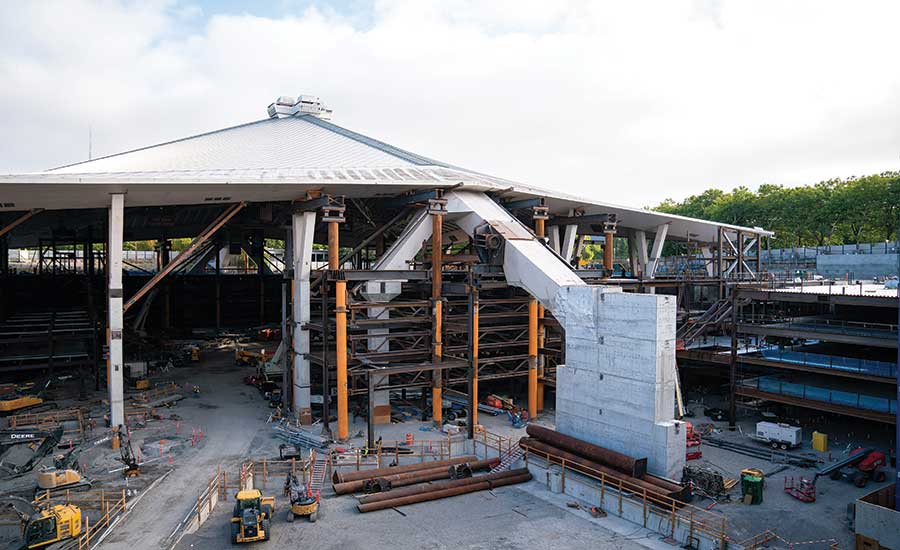Top 15 Construction Issues & Industry Challenges in 2024
- Introduction
- 1. Slow technological adoption speed
- 2. Managing documentation
- 3. Issues with cash flow
- 4. The problem of “pointing fingers”
- 5. Irregular equipment maintenance/replacement
- 6. “Forgetful” clients
- 7. Keeping up with compliance regulations
- 8. Construction safety
- 9. Working on a schedule
- 10. Communication problems
- 11. Lack of a skilled workforce
- 12. Insufficient productivity
- 13. Issues with supply chains
- 14. Vandalism/theft on site
- 15. Lack of reliable subcontractors
- The future of the construction industry

Introduction
The construction industry has been living through an exciting phase, growing nonstop, and facing many challenges simultaneously. A single construction contractor in the U.S. called the Turner Corporation managed to acquire over 16 billion U.S. dollars by the end of 2022. That same year, the overall construction market in the United States reached over 1.8 trillion U.S. dollars – a very lucrative market for most companies involved.
That is not to say that the industry is easy to work in. It has plenty of issues, some relatively new, while others are decades old. There are a variety of different approaches to these construction issues. For example, slow rates of technological adoption are sometimes treated as a single big challenge, and sometimes as a multitude of problems, including communication problems, scheduling issues, and problems with documentation.
Now, we will go over some of the most significant issues in the construction industry, starting with the problem of compliance in a world of constantly changing rules and regulations. Other issues will be mentioned, too. We will also attempt to offer solutions to these issues, no matter how insignificant or ineffective they may seem.
1. Slow technological adoption speed
The construction industry is notoriously slow to adopt new technologies, and the problem has existed for a long time. Even though many business owners acknowledge the various benefits that newer technologies can provide, it is still fairly common for the technological departments of construction businesses to have relatively small budgets.
A solution to this issue
There are many different technologies and advancements that are rarely used by construction companies, including:
- Internet of things
- Drone surveillance
- VR/AR
- Wearables
- Robots, and more
Ironically, these technologies are incredibly beneficial in counteracting some of the oldest problems in the construction industry. As we have mentioned, one of these problems is scheduling, but it is not the only one on the list.
2. Managing documentation
Unsurprisingly, construction generally involves a lot of documentation, such as contracts, receipts, insurance certificates, and material orders. Dealing with all of this regularly makes the document management process slower and more prone to human error.
A solution to this issue
Running entire businesses mostly paperlessly has been possible for a while now. There are many systems and solutions on the market to help with document management in various ways, such as via categorization and monitoring due dates and project deadlines.
That being said, not all of the problems and issues in the construction industry are easily fixable or technology-related. Our next issue in construction is a clear example of that.
3. Issues with cash flow
Construction companies must have free cash to pay for several things semi-regularly. The list includes payments to subcontractors, vendors, suppliers, and employees. However, the payment for a completed project may come only once, after the project is completed.
A solution to this issue
Fund management is a surprisingly common problem among construction companies, and this can spawn an impressive number of issues. The only viable solution for these kinds of problems, aside from getting steady cash flow (which may not be feasible in some cases) is to have a line of business credit open for “worst-case scenarios” or to get through periods that are financially challenging for the company.
Financial issues are not the only ones you have to deal with when working on a construction project. Another relatively frequent problem comes from people’s unwillingness to take responsibility for anything.
4. The problem of “pointing fingers”
It is statistically impossible for construction projects to always go smoothly and without problems. And when a crisis happens, the finger-pointing begins, more often than not. For example, the contractor points fingers at subcontractors, the client blames the contractor and gets reprimanded by the project manager.
A solution to this issue
This kind of finger pointing (the “blame game,” as it’s sometimes called) is completely pointless and only prolongs the time frame for resolving the issue. A specific policy – a builder’s risk policy – can help with the problem.
A builder’s risk policy is a type of property insurance that covers the majority of possible problems that may happen during the construction process – from vandalism and theft to natural disasters and extreme weather conditions.
This policy can also be elevated to cover more questionable actions, such as the client claiming that they do not like the work after it is done and citing a contract breach. In these cases, the combination of a liability policy and faulty workmanship coverage can protect your side of the deal from paying extra for a project with a pre-established price tag.
5. Irregular equipment maintenance/replacement
One thing that many companies tend to skip over is construction equipment costs, or maintenance/replacement costs, to be specific. It is also one of the biggest reasons for project overrun costs, since replacing your equipment mid-construction means additional expenses. These expenses easily lead to less revenue from a project, as construction equipment tends to cost a lot of money.
A solution to this issue
Some of the means of trying to fix this problem include keeping a close eye on equipment that begins to show signs of malfunctioning all of a sudden and being quick on your feet if your equipment breaks down mid-construction (replacing it as soon as possible, whether via an equipment loan or by using funds on hand).
That is not to say that equipment costs are the entirety of project overrun costs. They may also be the result of the client “changing their mind” at the last minute.
6. “Forgetful” clients
This issue is somewhat similar to what we’ve discussed in the context of “pointing fingers,” since it is a similar type of client behavior. One of the most common cases here is for a client to request a change mid-project and then pretend to “forget” it when paying for the completed project.
A solution to this issue
The only way to avoid this situation is to get a signed change order for every change in your project if anything is requested after the initial plan is finalized.
Unfortunately, this questionable behavior is not limited to clients or owners, and the number of unreliable contractors is far more significant.
7. Keeping up with compliance regulations
Technology constantly changes and evolves, and the various rules and regulations must keep up. Keeping up with all this is challenging, especially since companies are affected by different levels of restrictions. This includes worldwide compliance rules and country-specific laws and regulations, or even things that are extremely local and specific for a single state or city.
It is not uncommon for regulation update messages to get lost and unnoticed in the daily flood of work-related mail. And yet, compliance breaches due to unnoticed changes can turn out to be disastrous for a company.
A solution to this issue
It is a good practice to try and reroute regulation-related messages to a specific place where you can find them more easily. Additionally, some people dedicate a part of their day to catching up with regulatory updates and rule changes.
8. Construction safety
The construction industry is well-known for its high risk of on-site injury. An essential part of any construction project is the stage where the building is physically created with the help of heavy machinery, weighty materials, and many construction workers. The nature of the work in the industry implies a significant possibility of an injury happening sooner or later.
A single on-site injury can be a massive problem for the company overseeing the construction project. The fact that the damage itself is often quite severe is an even bigger problem with factors such as lawsuits and insurance compensation. Depending on the position of the injured person, there may also be delays to the entire project if there is no ready replacement.
A solution to this issue
Most on-site construction injuries are entirely random, making it difficult to predict and counteract them beforehand. The best way to approach this is to adopt a more safety-focused attitude toward on-site work, investing more in protective equipment, safety training programs, and even safety protocols for when something happens or is about to happen.
9. Working on a schedule
While experience does matter, it is not uncommon for even the most knowledgeable of professionals to make mistakes when scheduling is managed manually. This is a problem that modern-day technology can mitigate to the highest degree with various automation systems, project management applications for different devices, and virtual task boards.
A solution to this issue
This is one of many problems that modern technology and its advantages can solve partially or entirely. However, this list would not be very long if it were not for another massive problem that the entire construction industry has been dealing with for a while now.
10. Communication problems
A surprisingly high percentage of problems within a construction project are directly related to the lack of timely communication between different teams and departments.
A solution to this issue
This is another massive problem that is easily solvable by modern-day technology in multiple ways. For example, your workers’ smartphones can make communication much faster (since billions of people worldwide have access to personal smartphones) – via emails, regular messages, or even various construction-related apps.
This approach can easily prevent most minor problems in the project from becoming more prominent and challenging, and it is also another example of technology bringing massive potential benefits to construction companies. On the topic of technologies, we are missing one more major field of work with the same possible solution.
11. Lack of a skilled workforce
The lack of a skilled workforce might be one of the biggest problems in the construction industry today, and it is one that also gets worse every year, with fewer and fewer young people interested in working in the construction industry and older employees being closer and closer to retirement.
The demand keeps growing regularly, and the problem is not specific to a single country or continent. While some initiatives have been attempted on that level to fix this problem, it is also possible for construction companies to try and mitigate the effects of the issue for themselves.
A solution to this issue
Two of the most significant potential approaches to this are mentoring and construction staffing agencies. Mentorship can work for inexperienced students/college graduates and existing skilled labor, allowing more potential employees to be brought in. On the other hand, staffing agencies are tasked with covering most of the recruiting and pre-screening, offering the workforce exactly when you need them.
12. Insufficient productivity
Productivity and efficiency have been some of the industry’s most prominent issues for a long time. Many technological advancements have been made in recent years to make most industries more productive, but the construction industry is not among them, and the overall stagnation of productivity is something everyone knows about already.
Customers’ expectations grow over time, and construction companies that do not want to evolve and change will sooner or later fall into obscurity, incapable of competing with other players on the market regarding budgets and deadlines.
A solution to this issue
Productivity is an extensive topic, and there is no single solution to this massive issue. In a way, the issue is similar to the problem of the slow adoption of technology that we mentioned above. Both of these issues have a relatively simple yet complicated solution: investment in the adoption of new technologies and methods. Transforming an existing company structure to enable the implementation of BIM is an excellent example of such an investment.
13. Issues with supply chains
The supply chain has never been a simple topic in this industry, and the arrival of the COVID-19 pandemic made it several times worse than ever before. With companies closing left and right, it was not surprising to see shipping times getting longer and prices rising all over the planet. The problem persists to this day, although it is better than it was just two or three years ago.
A solution to this issue
This problem may be one of the most difficult on this list because there has yet to be a simple solution to something that has plagued the entire planet for several years. There may be partial solutions to the problem, such as researching and investing in local material sourcing, using more efficient inventory management solutions, or optimizing a company’s supply chains by adding new potential suppliers.
14. Vandalism/theft on site
Theft and vandalism are issues that are not typically associated with the construction industry, but it is a problem that has existed for a long time and shows no signs of stopping. It is terrible for construction companies, since every missing or unusable piece of material decreases the overall margin of a project.
A solution to this issue
Fixing this problem requires some investments in regular surveillance equipment, such as fences, cameras, alarms, more lighting on-site, and more closed containers to store materials in.
15. Lack of reliable subcontractors
This construction issue is the one that hinges the most on networking and recommendations. The number of subcontractors on the market, in general, is massive, and it might take some time to pick one for the job without in-depth knowledge.
A solution to this issue
One excellent way to avoid picking an unreliable contractor is to ask your vendors or material suppliers for recommendations. Asking subcontractors you have worked with before also works wonders in finding reliable connections.
It is also recommended to check subcontractors’ licenses and general liability insurance and list yourself as additionally insured on their insurance before finalizing the hiring process.
The future of the construction industry
This industry has been around for a long time, changing and evolving multiple times before becoming the way it is now. Despite its setbacks, construction is still one of the most critical parts of the global economy. Even industries as conservative as the construction industry will have to evolve and improve sooner or later because of rising demand, rising quality standards, and shorter deadline expectations. Trying to do everything you can to get ahead of the competition in the industry is a given, and turning to new technologies might be the competitive edge some smaller companies need right now.
The construction industry is old and has been through a lot. Some of its problems are ancient, while others have become more prominent in recent years and were not a problem before. In this article, we have tried to go over the most significant construction issues on the market and some of the means of avoiding or eliminating them.


